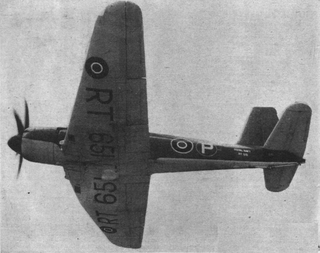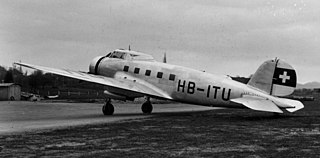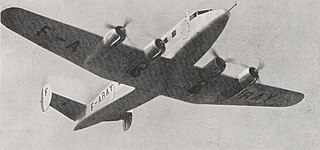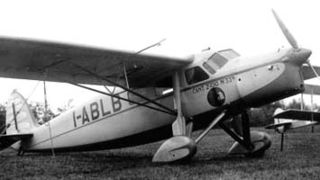
The Fieseler Fi 5 was a single-engined two-seat sportplane of the 1930s. It was produced by the German aircraft manufacturer Fieseler Flugzeugbau, which was started by the World War I fighter ace and German aerobatic star, Gerhard Fieseler.

The Blackburn B.48 Firecrest, given the SBAC designation YA.1, was a single-engine naval strike fighter built by Blackburn Aircraft for service with the British Fleet Air Arm during the Second World War. It was a development of the troubled Firebrand, designed to Air Ministry Specification S.28/43, for an improved aircraft more suited to carrier operations. Three prototypes were ordered with the company designation of B-48 and the informal name of "Firecrest", but only two of them actually flew. The development of the aircraft was prolonged by significant design changes and slow deliveries of components, but the determination by the Ministry of Supply in 1946 that the airframe did not meet the requirements for a strike fighter doomed the aircraft. Construction of two of the prototypes was continued to gain flight-test data and the third was allocated to strength testing. The two flying aircraft were sold back to Blackburn in 1950 for disposal and the other aircraft survived until 1952.
The Arpin A-1 was a two-seat low-wing monoplane which was powered by a single radial engine in pusher configuration, mounted behind the cabin between twin booms that carried the tail. An unconventional fixed tricycle undercarriage was fitted. Only one was built.
The SIAI-Marchetti SM.101 was a 1940s Italian single-engined light transport cabin monoplane designed and built by SIAI-Marchetti.

The Fokker F.XIV was a cargo plane built in the Netherlands in the late 1920s by Fokker. It was a high-wing cantilever monoplane of conventional trimotor layout. The sole example was tested by KLM but never put into service.

The General Aviation GA-43 was a single engine low-wing monoplane airliner produced in small numbers in the United States in the mid-1930s, also known as the Pilgrim 150, Fairchild 150, and sometimes but erroneously as the Clark GA-43 for the designer, Virginius E. Clark who was also responsible for the Clark Y airfoil section used.

The Bullet Monoplane or Alexander Eaglerock Bullet was a low wing cabin monoplane that was a departure from traditional biplane aircraft of the era.
The Deekay Knight was a British two-seat cabin monoplane designed by S.C.Hart-Still and built in 1937 by the Deekay Aircraft Corporation at Broxbourne in Hertfordshire, England. It was built to test methods of wing construction that would later be suitable for plastic skinning.

The RWD-11 was a six-passenger feeder-liner designed and built in Poland from 1932.

The Potez 662 was a higher powered and faster development of the Potez 661. Like its predecessor, it was a low wing, four engine monoplane carrying 12 passengers. Only one was built, serving with the French Air Ministry.

The Latécoère 350 was a trimotor development of the Latécoère 28, a successful single-engined French monoplane of around 1930. The three engines were intended to provide the reliability needed for overnight flights, but the 350 came out very overweight. Only one was built.

The Ago Ao 192 Kurier was a small German twin-engined aircraft designed and built by AGO Flugzeugwerke in the 1930s. A small production run of six aircraft followed three prototypes, these being used as transports.

The Burnelli CB-16, also known as the Uppercu-Burnelli CB-300, was a passenger aircraft designed by the American company Burnelli in 1928. It was the first twin-engined aircraft to have retractable landing gear. Only one was built.

The Wibault 360 was a 1930s French five-passenger airliner designed and built by the Wibault company.

The CANT Z.1010 was a single engine, five seat Italian passenger aircraft flown in the mid-1930s. Only one was built.

The Aviamilano F.14 Nibbio is a four-seat, single engine cabin monoplane built in Italy in the late 1950s. Only ten production aircraft were completed.
The SABCA S.11 or SABCA S.XI was a prototype Belgian airliner of the 1930s. It was a three-engined high-winged monoplane intended for service in the Belgian Congo, but only a single example was built.

The G.A.C. 102 Aristocrat or General 102 Aristocrat is a single-engined cabin monoplane built in the US just before the Great Depression. It proved popular, with over forty built; an early example was taken on an aerial survey of Antarctica. One survives.

The Działowski D.K.D.1 was the first powered aircraft designed by Stanislaw Działowski. It was a low-power high-wing monoplane with a cabin for one passenger. After attending an aviation exhibition in Warsaw in 1927 it was badly damaged when the engine failed as it left and it did not fly again.

The Zenith Albatross Z-12 was a large, three-engined airliner built in the United States in 1928. It could carry up to 11 passengers. Only one was completed.
















